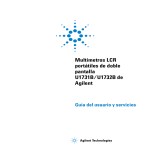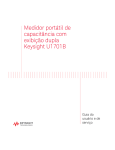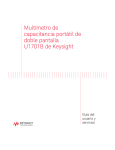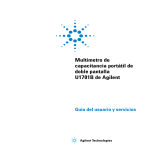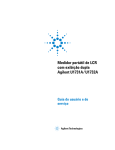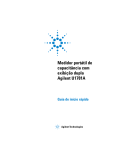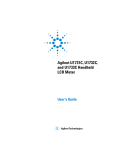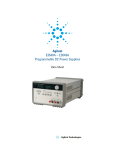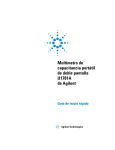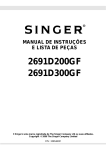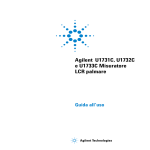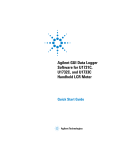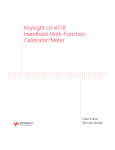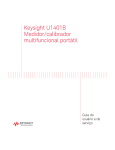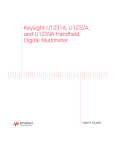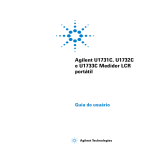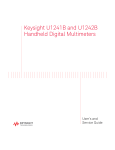Download U1732B User`s Guide
Transcript
Agilent U1731B/U1732B Dual Display Handheld LCR Meter User’s and Service Guide Agilent Technologies Notices © Agilent Technologies, Inc. 2009 – 2012 Warranty No part of this manual may be reproduced in any form or by any means (including electronic storage and retrieval or translation into a foreign language) without prior agreement and written consent from Agilent Technologies, Inc. as governed by United States and international copyright laws. The material contained in this document is provided “as is,” and is subject to being changed, without notice, in future editions. Further, to the maximum extent permitted by applicable law, Agilent disclaims all warranties, either express or implied, with regard to this manual and any information contained herein, including but not limited to the implied warranties of merchantability and fitness for a particular purpose. Agilent shall not be liable for errors or for incidental or consequential damages in connection with the furnishing, use, or performance of this document or of any information contained herein. Should Agilent and the user have a separate written agreement with warranty terms covering the material in this document that conflict with these terms, the warranty terms in the separate agreement shall control. Manual Part Number U1731-90059 Edition Third Edition, March 21, 2012 Printed in Malaysia Agilent Technologies, Inc. 5301 Stevens Creek Blvd. Santa Clara, CA 95051 USA Safety Notices Technology Licenses The hardware and/or software described in this document are furnished under a license and may be used or copied only in accordance with the terms of such license. Restricted Rights Legend CAUTION A CAUTION notice denotes a hazard. It calls attention to an operating procedure, practice, or the like that, if not correctly performed or adhered to, could result in damage to the product or loss of important data. Do not proceed beyond a CAUTION notice until the indicated conditions are fully understood and met. WA R N I N G A WARNING notice denotes a hazard. It calls attention to an operating procedure, practice, or the like that, if not correctly performed or adhered to, could result in personal injury or death. Do not proceed beyond a WARNING notice until the indicated conditions are fully understood and met. U.S. Government Restricted Rights. Software and technical data rights granted to the federal government include only those rights customarily provided to end user customers. Agilent provides this customary commercial license in Software and technical data pursuant to FAR 12.211 (Technical Data) and 12.212 (Computer Software) and, for the Department of Defense, DFARS 252.227-7015 (Technical Data - Commercial Items) and DFARS 227.7202-3 (Rights in Commercial Computer Software or Computer Software Documentation). II U1731B/U1732B User’s and Service Guide Safety Symbols The following symbols on the instrument and in the documentation indicate precautions that must be taken to maintain safe operation of the instrument. Direct current Off (supply) Alternating current On (supply) Both direct and alternating current Equipment protected throughout by double insulation or reinforced insulation. Three-phase alternating current Caution: risk of electric shock. Earth (ground) terminal Caution: risk of danger (refer to this manual for specific Warning or Caution information. Protective conductor terminal Caution: hot surface. Frame or chassis terminal Out position of a bi-stable push control. Equipotentiality In position of a bi-stable push control. U1731B/U1732B User’s and Service Guide III Regulatory Markings The CE mark is a registered trademark of the European Community. This CE mark shows that the product complies with all the relevant European Legal Directives. The C-tick mark is a registered trademark of the Spectrum Management Agency of Australia. This signifies compliance with the Australia EMC Framework regulations under the terms of the Radio Communication Act of 1992. ICES/NMB-001 indicates that this ISM device complies with Canadian ICES-001. This instrument complies with the WEEE Directive (2002/96/EC) marking requirement. This affixed product label indicates that you must not discard this electrical/electronic product in domestic household waste. Waste Electrical and Electronic Equipment (WEEE) Directive 2002/96/EC This instrument complies with the WEEE Directive (2002/96/EC) marking requirement. This affixed product label indicates that you must not discard this electrical/electronic product in domestic household waste. Product Category: With reference to the equipment types in the WEEE directive Annex 1, this instrument is classified as a “Monitoring and Control Instrument” product. The affixed product label is shown as below: Do not dispose in domestic household waste To return this unwanted instrument, contact your nearest Agilent office, or visit: www.agilent.com/environment/product for more information. IV U1731B/U1732B User’s and Service Guide General Safety Information The following general safety precautions must be observed during all phases of operation, service, and repair of this instrument. Failure to comply with these precautions or with specific warnings elsewhere in this manual violates safety standards for design, manufacture, and intended use of the instrument. Agilent Technologies assumes no liability for the customer’s failure to comply with these requirements. WA R N I N G • • • • • • • • CAUTION • This meter is for indoor use at an altitude of up to 2,000 m. The warnings and precautions should be read and well understood before the meter is used. Use this meter only as specified in this manual; otherwise, the protection provided by the meter may be impaired. When measuring in-circuit components, first de-energize the circuits before connecting them to the test leads. Discharge the capacitor before testing. The meter is safety-certified in compliance with IEC 61010-1. Use the meter only as specified in this manual. Otherwise, the protection provided by the meter may be impaired. The power for the meter is supplied with a single standard 9 V battery. Line operation is also possible using a 12 VAC to DC adaptor. If a power adaptor is selected, please be sure to meet the safety requirements of a relevant IEC standard. Ensure proper insertion of the battery in the LCR meter, and follow the correct polarity. U1731B/U1732B User’s and Service Guide V Environmental Conditions This instrument is designed for indoor use in areas with low condensation and to be used with standard or compatible test probes. Table 1 shows general environment requirements. Table 1 VI Environment requirements Environment Conditions Requirements Operating environment 0 °C to 40 °C; 0 – 70% R.H. Storage humidity 0 – 80% R.H. non condensing Storage environment –20 °C to +50 °C; 0 – 80% R.H. Altitude 0 – 2,000 meters Pollution degree Pollution degree 2 U1731B/U1732B User’s and Service Guide CAUTION The U1731B/U1732B dual display handheld LCR meter complies with the following safety and EMC requirements: • • • • • • • • • • CAUTION IEC 61010-1:2001/EN 61010-1:2001 (2nd Edition) CISPR 11:2003+A1:2004 IEC 61000-4-2:1995+A1:1998 +A2:2000 IEC 61000-4-3:2006 IEC 61000-4-4:2004 IEC 61000-4-5:2005 IEC 61000-4-6:2003+A1:2004+A2:2006 IEC 61000-4-11:2004 Canada: ICES/NMB-001:2004 Australia/New Zealand: AS/NZS CISPR11:2004 Degradation of some product specifications can occur in the presence of ambient electromagnetic (EM) fields and noise that affects the product's power line, communication, or I/O cables. The product self-recovers and operates to all specifications when: • the source of the ambient EM field and noise is removed, • the product is protected from the ambient EM field, or • the product cabling is shielded from the ambient EM noise. U1731B/U1732B User’s and Service Guide VII Declaration of Conformity (DoC) The Declaration of Conformity (DoC) for this instrument is available on the Web site. You can search the DoC by its product model or description. http://regulations.corporate.agilent.com/DoC/search.htm NOTE VIII If you are unable to search for the respective DoC, please contact your local Agilent representative. U1731B/U1732B User’s and Service Guide In This Guide… 1 Getting Started Chapter 1 introduces key features and steps to get started with a U1731B/U1732B dual display handheld LCR meter. This chapter also guides you through the basics of the front panel operations. 2 Features and Functions Chapter 2 explains how to set up connections to perform meter measurements. It also describes the features and functions that are available in the U1731B/U1732B dual display handheld LCR meter in step-by-step instructions. 3 Service and Maintenance Chapter 3 explains the services and maintenance procedures for the U1731B/U1732B dual display handheld LCR meter. 4 Specifications Chapter 4 lists the specifications and characteristics of the U1731B/U1732B dual display handheld LCR meter. U1731B/U1732B User’s and Service Guide IX X U1731B/U1732B User’s and Service Guide Contents Contents 1 Getting Started Introduction 2 Checking the Shipping Contents 3 The Front Panel at a Glance 4 Display Annunciators 5 The Keypad at a Glance 7 The Input Terminal at a Glance 8 2 Features and Functions Inductance Measurement 10 Capacitance Measurement 11 Resistance Measurement 12 Data Hold 13 Static Recording 13 Dissipation Factor/Quality Factor/Phase Angle 13 Test Frequency 14 LCR Function Selector 14 Relative 14 Tolerance 15 Auto/Manual Range 15 Automatic Fuse Detection 16 Parallel/Series Mode 16 CAL Function 17 Enable/Disable Auto Power-Off 19 Low Battery Indication 19 Backlit Display (Only Available for U1732B) 19 Communication (Optional Accessories) 20 3 Service and Maintenance Service 22 Battery Replacement 22 U1731B/U1732B User’s and Service Guide XI Contents Fuse Replacement 24 Replacement Parts 25 Cleaning the LCR Meter 26 Specification Validation 27 4 Specifications U1731B Electrical Specifications 26 U1732B Electrical Specifications 29 General Specifications 33 SMD Tweezers Specifications 35 XII U1731B/U1732B User’s and Service Guide U1731B/U1732B Dual Display Handheld LCR Meter User’s and Service Guide 1 Getting Started Introduction 2 Checking the Shipping Contents 3 The Front Panel at a Glance 4 Display Annunciators 5 The Keypad at a Glance 7 The Input Terminal at a Glance 8 This chapter introduces the key features and getting- started tips for the U1731B/U1732B dual display handheld LCR meter. This chapter also guides you through the basics of the front panel operations. Agilent Technologies 1 1 Getting Started Introduction The 20,000- count dual display handheld LCR meters (U1731B and U1732B) are special microprocessor- controlled meters for inductance, capacitance, and resistance measurements. The LCR meter is simple to operate and is capable of making absolute parallel mode measurements as well as series mode measurement. The LCR meter provides direct and accurate measurements of inductors, capacitors, and resistors with different testing frequencies. It offers both automatic and manual range selection. The front panel keypad makes it convenient to select features and functions such as data hold, maximum, minimum, and average record mode, relative mode, tolerance sorting mode, frequency selection, and LCR selection. The test data can be transferred to a PC via an optional full isolated optical IR- USB interface. The U1732B offers backlight display capability for better visibility in the dark. A tilt stand gives you flexibility in positioning the LCR meter for viewing and operating. The over- molding rubber case protects the LCR meter. Single 9 V battery operation is standard for the LCR meter, but a DC 12 V power adaptor can also be used as a power input. 2 U1731B/U1732B User’s and Service Guide Getting Started 1 Checking the Shipping Contents Inspect and verify that you have received the following items for the standard purchase of the U1731B/U1732B and/or accessories that you may have ordered. If any of the item listed below are missing, contact your nearest Agilent Technologies sales office. Table 1-1 List of standard and optional accessories Type Part Number Standard Accessories Agilent U1731B/U1732B Quick Start Guide Alligator clip leads 9 V Alkaline battery Certificate of Calibration (CoC) Optional U5481A IR to USB cable U1780A Power adaptor U1782A SMD tweezers U1174A Soft carrying case U1731B/U1732B User’s and Service Guide 3 1 Getting Started The Front Panel at a Glance Annunciator display Keypad Input terminals U1731B U1732B Figure 1-1 Front panel of U1731B and U1732B dual display handheld LCR meter 4 U1731B/U1732B User’s and Service Guide Getting Started 1 Display Annunciators 8 9 10 11 12 13 14 15 16 17 18 19 7 6 5 20 21 22 23 24 25 4 3 2 1 Figure 1-2 LCD display Table 1-1 Descriptions of each annunciator No. Symbols Descriptions 1 Low battery indicator 2 Reading out of LO limit 3 Primary display 4 Reading out of HI limit 5 Auto power off indicator 6 7 8 TOL 1% 5% 10% 20% Tolerance mode, to set 1%, 5%, 10%, and 20% for sorting capacitance AUTO AUTO range C Inductance, Capacitance, or Resistance (L,C, or R) function indicator U1731B/U1732B User’s and Service Guide 5 1 Getting Started MAX AVG MIN Static recording mode MAX: Maximum reading 9 AVG: Average reading MIN: Minimum reading 10 REL Relative mode 11 DH Data hold to hold the displayed digital value 12 q Phase angle indicator (only applicable for U1732B) 13 D Dissipation factor indicator 14 Q Quality factor indicator 15 Secondary display 16 Audible alert for tolerance and compare mode 17 % Unit for tolerance display (percentage) 18 deg Unit for phase angle (degree) (only applicable for U1732B) 19 kHz Unit for beeper frequency as setup mode 20 PAL Parallel mode indicator 21 SER Series mode indicator 22 mkW Unit for resistance (kΩ and MΩ) 23 Unit for inductance (µH and mH) 24 Unit for capacitance (pF, nF, µF, and mF) 25 Remote control Special indication characters 6 Descriptions Descriptions Indicates short connectors Indicates calibration mode Indicates open connectors Indicates damaged or open fuse U1731B/U1732B User’s and Service Guide Getting Started 1 The Keypad at a Glance 9 1 8 2 7 3 6 4 5 Figure 1-3 Keypad of U1731B/U1732B dual display handheld LCR meter Table 1-2 Keypad descriptions and functions No. Keys 1 Functions Power To turn ON/OFF the instrument 2 D/Q/θ To select dissipation factor, quality factor, and phase angle display (only applicable for U1732B) 3 L/C/R P↔S To select inductance, capacitance, and resistance measurement 4 TOL Tolerance mode 5 FREQ To select test frequency REL Relative mode CAL Calibration mode Manual Manual range AUTO Auto range HOLD Data hold REC Static recording mode REMOTE To toggle ON/OFF the remote function 6 7 8 9 To toggle parallel and series mode Backlight display (only applicable for U1732B) U1731B/U1732B User’s and Service Guide 7 1 Getting Started The Input Terminal at a Glance To avoid damaging this instrument, do not exceed the input limit. Do not apply voltage to input terminals. Discharge the capacitor before testing. WA R N I N G 2 1 3 Figure 1-4 Input terminals/sockets of U1731B/U1732B dual display handheld LCR meter No. Terminals Functions 8 1 + Positive terminal/socket 2 – Negative terminal/socket 3 GUARD Guard terminal/socket U1731B/U1732B User’s and Service Guide U1731B/U1732B Dual Display Handheld LCR Meter User’s and Service Guide 2 Features and Functions Inductance Measurement 10 Resistance Measurement 12 Data Hold 13 Static Recording 13 Dissipation Factor/Quality Factor/Phase Angle 13 Test Frequency 14 LCR Function Selector 14 Relative 14 Tolerance 15 Auto/Manual Range 15 Automatic Fuse Detection 16 Parallel/Series Mode 16 CAL Function 17 Enable/Disable Auto Power-Off 19 Low Battery Indication 19 Backlit Display (Only Available for U1732B) 19 Communication (Optional Accessories) 20 This chapters provides detailed information on the features and functions that are available in the U1731B/U1732B dual display handheld LCR meter. Agilent Technologies 9 2 Features and Functions Inductance Measurement Figure 2-1 Inductance measurement 1 Press the key to power- on the LCR meter. 2 Press the L/C/R key to select inductance (L) measurement. 3 Insert an inductor into component receptacle socket or connect the test clip to the component leads as required. 4 Press the FREQ key to select testing frequency. 5 Press the D/Q or D/Q/q key to select Q factor for secondary display. 6 Read the display readings for inductance value and quality factor. NOTE 10 It is recommended that you calibrate the LCR meter before testing to achieve optimum precision for all L, C, and R measurements at either the highest or lowest ranges. U1731B/U1732B User’s and Service Guide Features and Functions 2 WA R N I N G To avoid electrical hazards, discharge the capacitor to be tested before measuring. Capacitance Measurement Figure 2-2 Capacitance measurement 1 Press the key to turn on the LCR meter. 2 Press the L/C/R key to select capacitance (C) measurement. 3 Insert a capacitor into the component receptacle socket or connect the test clip to the component leads as required. 4 Press the FREQ key to select testing frequency. 5 Press the D/Q or D/Q/q key to select D factor for secondary display. 6 Read the display readings for capacitance value and dissipation factor. U1731B/U1732B User’s and Service Guide 11 2 Features and Functions Resistance Measurement Figure 2-3 Resistance measurement 1 Press the key to turn on the LCR meter. 2 Press the L/C/R key to select Resistance measurement. 3 Insert a resistor into the component receptacle socket or connect the test clip to the component leads as required. 4 Press the FREQ key to select testing frequency. 5 Read the display readings for resistance value. 12 U1731B/U1732B User’s and Service Guide Features and Functions 2 Data Hold The data- hold function allows the user to freeze the display. To enter this mode, press the HOLD key. Press the key again to release. Static Recording Press the REC key for more than one second to enter the static recording mode. The maximum and minimum readings are then stored in memory. The beeper will beep once when a new reading has been recorded. Press the same key to cycle through the maximum, minimum, and average of the present readings. The MAX, MIN, or AVG annunciator will appear on the display to indicate which value is being displayed. Whenever the MAX AVG MIN anunciators appear on the display simultaneously, the display reading is always a present value. To exit this mode, press and hold the key for more than one second. NOTE 1 Static recording captures only stable values and updates the memory; it will not record any overload (OL) value for any of the LCR functions. In addition, the LCR meter will not record values below 50 counts in capacitance measurement. 2 Static recording is only available in manual ranging; however, activation while in auto-ranging will automatically set the LCR meter to manual ranging and cause calibration prompts to be displayed in the recommended ranges. Dissipation Factor/Quality Factor/Phase Angle The D/Q/ q values can be displayed interchangeably by pressing the D/Q/ q key when the LCR meter is set to inductance or capacitance mode. This setting does not apply to resistance measurement. The phase angle mode (q) is only available for the U1732B. U1731B/U1732B User’s and Service Guide 13 2 Features and Functions Test Frequency The testing frequency is set to 1 kHz by default. Press the FREQ key to select the desired test frequency. LCR Function Selector Press the L/C/R key to select the L, C, or R function as desired. Relative Press the REL key to enter the relative mode and store the display reading as a reference value. It will then display all subsequent readings relative to reference value. Press the key again to exit the relative mode. NOTE 14 1 The relative mode cannot be activated if the display value is either "OL" or "0000". 2 Relative mode is only available in manual ranging; however, activation while in auto-ranging will automatically set the LCR meter to manual ranging and cause calibration prompts to be displayed in the recommended ranges. 3 The relative mode cannot be activated if the LCR meter is set at auto-ranging with data hold activated. U1731B/U1732B User’s and Service Guide Features and Functions 2 Tolerance The tolerance ranges available are 1%, 5%, 10%, and 20%. To enter tolerance mode, insert the appropriate component as a standard value into the socket or connect the component to the test probes, then press the TOL key to set this value, as the standard reference tolerance. Similarly, any value which appears on the display, such as DH or MAX/MIN/AVG, can be used as a standard value to sort components. Press this key again to cycle through 1%, 5%, 10% and 20% tolerance as desire. This function is designed for convenient component sorting. The beeper will beep three times whenever the component under test exceeds the setting tolerance. Conversely, when the beeper beeps once, this indicates that the component is within the setting tolerance. NOTE 1 The tolerance mode cannot be activated if "OL” or "0000" is shown on the display or when the tested capacitance value is below 10 counts. 2 Tolerance mode is only available in manual ranging; however, activation while in auto-ranging will automatically set the LCR meter to manual ranging and cause calibration prompts to be displayed in the recommended ranges. 3 The tolerance mode cannot be activated if the LCR meter is set to auto-ranging with data hold mode activated. 4 The 20% tolerance selection is only available for U1732B. Auto/Manual Range The LCR meter is set to auto- ranging mode by default when the meter is powered- on. For specific measurement, press AUTO/MANUAL key to select manual ranging. To return to the auto- ranging mode, press and hold the AUTO/MANUAL key for more than one second. U1731B/U1732B User’s and Service Guide 15 2 Features and Functions Automatic Fuse Detection When the LCR meter detects that the protective fuse is open or damaged, the FUSE character (as shown in Figure 2- 4) will appear on the display and the beeper will beep continuously. In this situation, none of the function keys can be operated and all other LCR meter functions will be discontinued. Fuse replacement is required. To replace protective fuse, refer to Chapter 3, “Fuse Replacement”. Figure 2-4 Fuse detection Parallel/Series Mode The LCR meter can display parallel (PAL) and series (SER) mode data for all ranges. For capacitance and resistance measurements, the LCR meter is set to parallel mode by default. Series mode is the default setting for inductance measurement. Press the L/C/R key for more than one second to toggle PAL and SER mode. 16 U1731B/U1732B User’s and Service Guide Features and Functions 2 CAL Function The CAL function is a correction function which enables the LCR meter's internal parameters and external connector residues to be offset (corrected) to achieve measurements with higher accuracy. The CAL function is only available for extremely high or low L, C, and R ranges. It is highly recommended that you correct extremely high or low ranges for L, C, and R before making precision measurements. Correction (CAL) prompts will be displayed automatically every time these ranges are manually or functionally selected, (e.g. REL, TOL, REC, etc.) and therefore correction is recommended. Figure 2-5 Open calibration and short calibration Measurements performed in extremely high or low ranges that require corrections are predefined as “open cal” or “short cal”. Refer to the “Specified Note” column of any of the L, C, or R measurement from Chapter 4, “U1731B Electrical Specifications,” starting on page 26 or Chapter 4, “U1732B Electrical Specifications,” starting on page 29 to find out which of these measurement ranges are indicated with “After open cal” or “After short cal”. These predefined ranges will require you to connect the terminal connection as “open” or “short” to achieve the accuracy in the table. U1731B/U1732B User’s and Service Guide 17 2 Features and Functions Follow the instructions below to perform the CAL function: 1 Press and hold the CAL key for more than one second to enter CAL mode. 2 CAL prompts will be shown on the display. 3 Press the MANUAL key to select the desired range for correction. Follow the prompts instruction on the upper right of the display of the selected range for the terminal connection. Leave the positive and negative connector terminals open for open connector (OPn) connection, or short the connector terminals at short connector (Srt) connection. 4 Press the CAL key to start the correction function. The OPn or Srt annunciator on the upper right of the display will disappear to indicate the start of the correction process. To skip the correction process, press D/Q/θ. 5 The CAL annunciator on the main display will disappear once the correction process is completed. The LCR meter will be restored to the normal display and ready to perform measurement. NOTE 18 1 Changing measurement frequencies is handled the same way as selecting a different hardware range, and the automatic calibration prompts will be displayed in the recommended ranges. 2 Ensure that the same testing position is used after short calibration. U1731B/U1732B User’s and Service Guide Features and Functions 2 Enable/Disable Auto Power-Off When the LCR meter has not been used for five minutes since the last operation, the beeper will beep a long tone. Then the LCR meter will automatically enter sleep mode and none of the anunciators will shown on the display. To re- activate the LCR meter, press any key. When the LCR meter must be used for a longer period, the auto power- off function can be disabled. To disable auto power- off, press and hold the L/C/R key while turning LCR meter ON. Release the L/C/R key and press any key again. The annunciator will disappear. This will confirm that the auto power- off function has been disabled. When a 12 VAC adaptor is used as an optional power source, the auto power- off function is automatically disabled. NOTE It is recommended that the LCR meter should always be powered off when not in use. Low Battery Indication When the annunciator is blinking on the display, this shows that the battery voltage is below normal working voltage and is weakening. Replace the battery with a new battery to maintain the precision of the LCR meter. To replace the battery, refer to Chapter 3, “Battery Replacement”. Backlit Display (Only Available for U1732B) Press and the hold key for more than one second to toggle backlit ON/OFF. This function is only available for the U1732B. U1731B/U1732B User’s and Service Guide 19 2 Features and Functions Communication (Optional Accessories) The LCR meter can be adapted for communication capability. The optional IR- USB package comes with a full optically- isolated cable and software. This function enables you to record data easily. To use this function, you will need a U1173A IR- to- USB cable (purchased separately) and the data logging software. You can download the data logging software from the Agilent web site at: http://www.agilent.com.find/hhTechlib. Refer to the following procedure to set up the communication between your LCR meter and personal computer (PC). 1 Connect one side of the cable to the meter with the Agilent logo facing up and connect the USB connector to the PC. 2 Press the REMOTE key to enable this interface; the annunciator will be shown on the display. 3 Run the Data Logger software to transfer the data to the PC for your applications. 4 To remove the cable, press and pull the snap ends on each side of the cable that is connected to the meter. The side with the Agilent logo must be facing up Connect to the PC’s USB port Press the snaps to remove the cable Figure 2-6 Cable connection for remote communication 20 U1731B/U1732B User’s and Service Guide U1731B/U1732B Dual Display Handheld LCR Meter User’s and Service Guide 3 Service and Maintenance Service 22 Battery Replacement 22 Fuse Replacement 24 Replacement Parts 25 Cleaning the LCR Meter 26 Specification Validation 27 This chapter describes the service and maintenance procedures for the U1731B/U1732B dual display handheld LCR meter. Repair or service that are not covered in this manual should only be performed by qualified personnel. Agilent Technologies 21 3 Service and Maintenance Service WA R N I N G To avoid electrical shock, do not perform any service unless you are qualified to do so. If the instrument fails to operate, check the battery and test leads. Replace the battery or test leads if necessary. If the instrument still cannot function, check again the operating procedures described in this instruction manual. When servicing, use specified replacement parts only. The LCR meter must be completely turned off while replacing either the fuse or battery. Battery Replacement WA R N I N G Do not discharge the battery by shorting the battery or reversing the battery polarity. CAUTION To avoid instruments being damage from battery leakage: • Always remove dead batteries immediately. • Always remove the battery and store it separately if the LCR meter is not going to be used for a long period. The LCR meter is powered by a single 9 V alkaline battery. Replace the battery if the low battery sign ( ) is displayed and flashing. Use the following procedures to replace the battery. 1 Loosen screws with a suitable screwdriver and remove the battery cover as shown in Figure 3- 1. 2 Replace the degraded battery with a new battery. 22 U1731B/U1732B User’s and Service Guide Service and Maintenance 3 Battery cover screw Figure 3-1 Battery replacement U1731B/U1732B User’s and Service Guide 23 3 Service and Maintenance Fuse Replacement NOTE Users should use clean/dry gloves when performing fuse replacement. Do not touch any components except the fuse and plastic parts. No recalibration is required after replacing the fuse. The LCR meter is able to self- detect if the input protective fuse is either open or damaged. In this case, the display will show FUSE and beep will sound continuously, warning the user to replace the damaged fuse to maintain the accuracy of measurement. While replacing the fuse, the LCR meter must be completely turned off. 1 Loosen screws with a suitable screwdriver and remove the battery cover as shown in Figure 3- 1. 2 Loosen screws with a suitable screwdriver and remove the bottom cover as shown in Figure 3- 2. 3 Replace the damaged fuse with the a new fuse as specified in Chapter 4, “General Specifications”. Bottom cover screw Battery cover screw Figure 3-2 Fuse replacement 24 U1731B/U1732B User’s and Service Guide Service and Maintenance 3 Replacement Parts This section explains how to order replacement parts for your instrument. To order replaceable parts You can order replaceable parts from Agilent using the Agilent part number. Note that not all parts listed in this chapter are available as field–replaceable parts. To order replaceable parts from Agilent, do the following. 1 Contact your nearest Agilent sales office or service center. 2 Identify the parts by the Agilent part number shown in the replaceable parts list. 3 Provide the instrument model number and serial number. Table 3-1 Replaceable parts Part Number Description A02-62-25612-2U Fuse U1731B/U1732B User’s and Service Guide 25 3 Service and Maintenance Cleaning the LCR Meter WA R N I N G To avoid electrical shock or damage to the LCR meter, never contact with water inside the case. Before cleaning the LCR meter, ensure that the LCR meter’s power is completely turned off and remove the external DC adaptor. To clean the LCR meter, wipe the dirty parts with gauze or soft cloth soaked mildly in diluted neutral detergent. After cleaning, ensure that the instrument is completely dried before using. 26 U1731B/U1732B User’s and Service Guide Service and Maintenance 3 Specification Validation You can perform self- validation of the LCR meter's accuracy by using the recommended equipment with the specified test ranges below. Table 3-1 Resistance ranges for functional validation Resistance (Parallel Mode), Test Frequency: 100 Hz, 120 Hz, 1000 Hz, or 10 kHz Recommended Equipment: IET 1433 Resistor Box Range (W) Test Value Used 200 k 100 k 2000 1000 20 10 Table 3-2 Capacitance ranges for functional validation Capacitance (Parallel Mode), Test Frequency: 100 Hz, 120 Hz, 1000 Hz, or 10 kHz Recommended Equipment: HACS-Z Precision Decade Capacitor Range (F) Test Value Used 20 µ 10 µ 200 n 100 n 20 n 10 n 200 p* 100 p * Does not support test frequency of 100 Hz, 120 Hz, and 1000 Hz U1731B/U1732B User’s and Service Guide 27 3 Service and Maintenance Table 3-3 Inductance ranges for functional validation Inductance (Series Mode), Test Frequency: 100 Hz, 120 Hz, 1000 Hz, or 10 kHz Recommended Equipment: GR1491 Precision Decade Inductor Range (H) Test Value Used 200 m 100 m 20 m 10 m 2000 µ* 1000 µ * Does not support test frequency of 100 Hz and 120 Hz 28 U1731B/U1732B User’s and Service Guide U1731B/U1732B Dual Display Handheld LCR Meter User’s and Service Guide 4 Specifications U1731B Electrical Specifications 26 U1732B Electrical Specifications 29 General Specifications 33 SMD Tweezers Specifications 35 This chapter contains the U1731B/U1732B dual display handheld LCR meter’s electrical and general specifications. Agilent Technologies 25 4 Specifications U1731B Electrical Specifications Accuracy is expressed as ± (% of reading + number of least significant digits) at 23 °C ± 5 °C and <75% R.H. Resistance (Parallel Mode), Test Frequency =120 Hz/1 kHz Range 10 MW 2000 KW 200 KW 20 KW 2000 W 200 W 20 W Maximum Display 9.999 MW 1999.9 KW 199.99 KW 19.999 KW 1999.9 W 199.99 W 19.999 W Accuracy @ 120 Hz 2.0% + 8* 0.5% + 5 0.5% + 3 0.5% + 3 0.5% + 3 0.8% + 5 1.2% + 40 @ 1 kHz 2.0% + 8* 0.5% + 5 0.5% + 3 0.5% + 3 0.5% + 3 0.8% + 5 1.2% + 40 Specified Note After open cal. After open cal. After short cal. After short cal. * This specification is based on the battery operation. NOTE 1 This specification is based on the measurement performed at the test socket. 2 Device Under Test (DUT) and test leads need to be properly shielded to GUARD if necessary. Capacitance (Parallel Mode), Test Frequency =120 Hz Range 10 mF 1000 µF 200 µF 20 µF 2000 nF 200 nF 20 nF Maximum Display 19.99 mF* 1999.9 µF† 199.99 µF 19.999 µF 1999.9 nF 199.99 nF 19.999 pF Accuracy Capacitance 3.0% +5 (DF<0.1) 1.0% + 5 (DF<0.1) 0.7% + 3 (DF<0.5) 0.7% + 3 (DF<0.5) 0.7% + 3 (DF<0.5) 0.7% + 5 (DF<0.5) 1.0% + 5 (DF<0.1) DF 10% + 100/Cx + 5 (DF<0.1) 2.0% + 100/Cx + 5 (DF<0.1) 0.7% + 100/Cx +5 (DF<0.5) 0.7% + 100/Cx + 5 (DF<0.5) 0.7% + 100/Cx + 5 (DF<0.5) 0.7% + 100/Cx + 5 (DF<0.5) 2.0% + 100/Cx + 5 (DF<0.1) Specified Note After short cal. After short cal. After open cal. After open cal. * This reading can be extended up to 1999 MAX display with accuracy that is not specified. † This reading can be extended up to 19999 MAX display with accuracy that is not specified. 26 U1731B/U1732B User’s and Service Guide Specifications 4 Capacitance (Parallel Mode), Test Frequency =1 kHz Range 1 mF 200 µF 20 µF 2000 nF 200 nF 20 nF 2000 pF Maximum Display 1.999 mF* 199.99 µF 19.999 µF 1999.9 µF 199.99 nF 19.999 nF 1999.9 pF Accuracy Capacitance 3.0% + 5 (DF<0.1) 1.0% + 5 (DF<0.1) 0.7% + 3 (DF<0.5) 0.7% + 3 (DF<0.5) 0.7% + 3 (DF<0.5) 0.7% + 5 (DF<0.5) 1.0% + 5 (DF<0.1) DF 10.0% + 100/Cx +5 (DF<0.1) 2.0%+ 100/Cx +5 (DF<0.1) 0.7% + 100/Cx +5 (DF<0.5) 0.7% + 100/Cx +5 (DF<0.5) 0.7% + 100/C x+5 (DF<0.5) 0.7% + 100/Cx +5 (DF<0.5) 2.0% + 100/Cx +5 (DF<0.1) Specified Note After short cal. After short cal. After open cal. After open cal. * This reading can be extended up to 1999 MAX display with accuracy that is not specified. NOTE NOTE 1 2 3 4 Q value is the reciprocal of DF. This specification is based on the measurement performed at the test socket. Device Under Test (DUT) and test leads need to be properly shielded to GUARD if necessary. Cx = Counts of displayed C value, e.g. C = 88.88 µF then Cx = 8888. It is recommended to set the test frequency to 1 kHz for a mult-layer ceramic capacitor of 10 μF and below. Inductance (Series Mode), Test Frequency =120 Hz Range 1000 H 200 H 20 H 2000 mH 200 mH 20 mH Maximum Display 999.9 H 199.99 H 19.999 H 1999.9 mH 199.99 mH 19.999 mH Accuracy Inductance DF 1.0% + (Lx/10000)% +5 2.0% + 100/Lx + 5 0.7% + (Lx/10000)% +5 1.2% + 100/Lx + 5 0.7% + (Lx/10000)% +5 1.2% + 100/Lx + 5 0.7% + (Lx/10000)% +5 1.2% + 100/Lx + 5 1.0% + (Lx/10000)% +5 3.0% + 100/Lx + 5 2.0% + (Lx/10000)% +5 10.0% + 100/Lx + 5 U1731B/U1732B User’s and Service Guide Specified Note After open cal. After short cal. After short cal. 27 4 Specifications Inductance (Series Mode), Test Frequency =1 kHz Range 100 H 20 H 2000 mH 200 mH 20 mH 2000 µH NOTE 28 Maximum Display 99.99 H 19.999 H 1999.9 mH 199.99 mH 19.999 mH 1999.9 µH 1 2 3 4 Accuracy Inductance DF 1.0% + (Lx/10000)% +5 2.0% + 100/Lx + 5 0.7% + (Lx/10000)% +5 1.2% + 100/Lx + 5 0.7% + (Lx/10000)% +5 1.2% + 100/Lx + 5 0.7% + (Lx/10000)% +5 1.2% + 100/Lx + 5 1.0% + (Lx/10000)% +5 3.0% + 100/Lx + 5 2.0% + (Lx/10000)% +5 10.0% + 100/Lx + 5 Specified Note After open cal. After short cal. After short cal. Q value is the reciprocal of DF. This specification is based on the measurement performed at the test socket. Device Under Test (DUT) and test leads need to be properly shielded to GUARD if necessary. Lx = Counts of displayed L value, e.g. L = 88.88 H then Lx = 8888. U1731B/U1732B User’s and Service Guide Specifications 4 U1732B Electrical Specifications Accuracy is expressed as ± (% of reading + number of least significant digits) at 23 °C ± 5 °C and <75% R.H. Resistance (Parallel Mode), Test Frequency = 100 Hz/120 Hz Range 10 MW 2000 kW 200 kW 20 kW 2000 W 200 W 20 W Maximum Display 9.999 MW 1999.9 kW 199.99 kW 19.999 kW 1999.9 W 199.99 W 19.999 W Accuracy @ 100 Hz 2.0% + 8* 0.5% + 5 0.5% + 3 0.5% + 3 0.5% + 3 0.8% + 5 1.2% + 40 @ 120 Hz 2.0% + 8* 0.5% + 5 0.5% + 3 0.5% + 3 0.5% + 3 0.8% + 5 1.2% + 40 Specified Note After open cal. After open cal. After short cal. After short cal. * This specification is based on the battery operation. Resistance (Parallel Mode), Test Frequency = 1 kHz/10 kHz Range 10 MW 2000 kW 200 kW 20 kW 2000 W 200 W 20 W Maximum Display 9.999 MW 1999.9 kW 199.99 kW 19.999 kW 1999.9 W 199.99 W 19.999 W Accuracy @ 1 kHz 2.0% + 8* 0.5% + 5 0.5% + 3 0.5% + 3 0.5% + 3 0.8% + 5 1.2% + 40 @ 10 kHz 3.5% + 10* 2.0% + 10 1.5% + 5 1.5% + 5 1.5% + 5 2.0% + 10 2.5% + 200 Specified Note After open cal. After open cal. After short cal. After short cal. * This specification is based on the battery operation. NOTE 1 This specification is based on the measurement performed at the test socket. 2 Device Under Test (DUT) & test leads needs to be properly shielded to GUARD if necessary. U1731B/U1732B User’s and Service Guide 29 4 Specifications Capacitance (Parallel Mode), Test Frequency = 100 Hz/120 Hz Range 10 mF 1000 µF 200 µF 20 µF 2000 nF 200 nF 20 nF Maximum Display 19.99 mF* 1999.9 µF† 199.99 µF 19.999 µF 1999.9 nF 199.99 nF 19.999 nF Accuracy Capacitance 3.0% + 5 (DF<0.1) 1.0% + 5 (DF<0.1) 0.7% + 3 (DF<0.5) 0.7% + 3 (DF<0.5) 0.7% + 3 (DF<0.5) 0.7% + 5 (DF<0.5) 1.0% + 5 (DF<0.1) DF 10.0% + 100/Cx + 5 (DF<0.1) 2.0% + 100/Cx + 5 (DF<0.1) 0.7% + 100/Cx + 5 (DF<0.5) 0.7% + 100/Cx + 5 (DF<0.5) 0.7% + 100/Cx + 5 (DF<0.5) 0.7% + 100/Cx + 5 (DF<0.5) 2.0% + 100/Cx + 5 (DF<0.1) Specified Note After short cal. After short cal. After open cal. After open cal. * This reading can be extended up to 1999 MAX display with accuracy that is not specified. † This reading can be extended up to 19999 MAX display with accuracy that is not specified. Capacitance (Parallel Mode), Test Frequency = 1 kHz Range 1 mF 200 µF 20 µF 2000 nF 200 nF 20 nF 2000 pF Maximum Display 1.999 mF* 199.99 µF 19.999 µF 1999.9 nF 199.99 nF 19.999 nF 1999.9 pF Accuracy Capacitance 3.0% + 5 (DF<0.1) 1.0% + 5 (DF<0.1) 0.7% + 3 (DF<0.5) 0.7% + 3 (DF<0.5) 0.7% + 3 (DF<0.5) 0.7% + 5 (DF<0.5) 1.0% + 5 (DF<0.1) DF 10% + 100/Cx + 5 (DF<0.1) 2.0% + 100/Cx + 5 (DF<0.1) 0.7% + 100/Cx + 5 (DF<0.5) 0.7% + 100/Cx + 5 (DF<0.5) 0.7% + 100/Cx + 5 (DF<0.5) 0.7% + 100/Cx + 5 (DF<0.5) 2.0% + 100/Cx + 5 (DF<0.1) Specified Note After short cal. After short cal. After open cal. After open cal. * This reading can be extended up to 1999 MAX display with accuracy that is not specified. 30 U1731B/U1732B User’s and Service Guide Specifications 4 Capacitance (Parallel Mode), Test Frequency = 10 kHz Range Maximum Display 50 µF 20 µF 2000 nF 200 nF 20 nF 2000 pF 200pF NOTE NOTE 50.0 µF 19.999 µF 1999.9 nF 199.99 nF 19.999 nF 1999.9 pF 199.99 pF 1 2 3 4 Accuracy Capacitance 3.0% + 8 (DF<0.1) 3.0% + 6 (DF<0.2) 1.5% + 5 (DF<0.5) 1.5% + 5 (DF<0.5) 1.5% + 5 (DF<0.5) 2.0% + 6 (DF<0.5) 3.0% + 8 (DF<0.1) DF 12.0% + 100/Cx + 10 (DF<0.1) 5.0% + 100/Cx + 8 (DF<0.2) 1.5% + 100/Cx + 6 (DF<0.5) 1.5% + 100/Cx + 6 (DF<0.5) 1.5% + 100/Cx + 6 (DF<0.5) 3.0% + 100/Cx + 6 (DF<0.1) 5.0% + 100/Cx + 8 (DF<0.1) Specified Note After short cal. After short cal. After open cal. After open cal. Q value is the reciprocal of DF. This specification is based on the measurement performed at the test socket. Device Under Test (DUT) and test leads need to be properly shielded to GUARD if necessary. Cx = Counts of displayed C value, e.g. C = 88.88 µF then Cx = 8888. It is recommended to set the test frequency to 1 kHz for a mult-layer ceramic capacitor of 10 μF and below Inductance (Series mode), Test Frequency = 100 Hz/120 Hz Range 1000 H 200 H 20 H 2000 mH 200 mH 20 mH Maximum Display 999.9 H 199.99 H 19.999 H 1999.9 mH 199.99 mH 19.999 mH Accuracy Inductance DF 1.0% + (Lx/10000)% + 5 2.0% + 100/Lx + 5 0.7% + (Lx/10000)% + 5 1.2% + 100/Lx + 5 0.7% + (Lx/10000)% + 5 1.2% + 100/Lx + 5 0.7% + (Lx/10000)% + 5 1.2% + 100/Lx + 5 1.0% + (Lx/10000)% + 5 3.0% + 100/Lx + 5 2.0% + (Lx/10000)% + 5 10.0% + 100/Lx + 5 U1731B/U1732B User’s and Service Guide Specified Note After open cal. After short cal. After short cal. 31 4 Specifications Inductance (Series Mode), Test Frequency = 1 kHz Range Maximum Display 100 H 20 H 2000 mH 200 mH 20 mH 2000 µH 99.99 H 19.999 H 1999.9 mH 199.99 mH 19.999 mH 1999.9 µH Accuracy Inductance DF 1.0% + (Lx/10000)% + 5 2.0% + 100/Lx + 5 0.7% + (Lx/10000)% + 5 1.2% + 100/Lx + 5 0.7% + (Lx/10000)% + 5 1.2% + 100/Lx + 5 0.7% + (Lx/10000)% + 5 1.2% + 100/Lx + 5 1.0% + (Lx/10000)% + 5 3.0% + 100/Lx + 5 2.0% + (Lx/10000)% + 5 10.0% + 100/Lx + 5 Specified Note After open cal. After short cal. After short cal. Inductance (Series Mode), Test Frequency = 10 kHz Range Maximum Display 1000 mH 200 mH 20 mH 2000 µH NOTE 32 999.9 mH 199.99 mH 19.999 mH 1999.9 µH 1 2 3 4 Accuracy Inductance 2.0% + (Lx/10000)% + 8 1.5% + (Lx/10000)% + 8 1.5% + (Lx/10000)% + 10 2.0% + (Lx/10000)% + 10 DF 2.0% + 100/Lx + 10 2.0% + 100/Lx + 10 3.0% + 100/Lx + 15 8.0% + 100/Lx + 20 Specified Note After short cal. Q value is the reciprocal of DF. This specification is based on the measurement performed at the test socket. Device Under Test (DUT) & test leads need to be properly shielded to GUARD if necessary. Lx = counts of displayed L value, e.g. L = 88.88 H, then Lx = 8888. U1731B/U1732B User’s and Service Guide Specifications 4 General Specifications Table 4-4 General characteristics of U1731B and U1732B Parameter Power supply U1731B U1732B Single standard 9 V battery (Alkaline) External DC adaptor (DC 12 VMIN — 15 VMAX, Load 50 mA minimum) Display L/C/R: Maximum display 19999 D/Q: Maximum display 999 (Auto Range) Measurements Measuring circuit mode L/C/R/D/Q L/C/R/D/Q/θ Inductance (L): Defaults to series mode Capacitance/Resistance (C/R): Defaults to parallel mode Ranging mode Measuring terminals Tolerance mode Auto & Manual Three terminals with sockets 1%, 5%, 10% 1%, 5%, 10%, 20% Test signal level Test frequency accuracy: ±0.1% ~0.6 VRMS 120 Hz = 120 Hz 100 Hz = 100 Hz 1 kHz = 1010 Hz 120 Hz = 120 Hz 1 kHz = 1010 Hz 10 kHz = 9.6 kHz Measuring rate 1 time/s, nominal Response time ~1 s/DUT (manual range) Auto power-off ~5 mins without operations Low battery indicator ~6.8 V Operating temperature 0 °C – 40 °C Storage temperature Storage humidity –20 °C – 60 °C (without battery) 0 – 80% R.H. Relative Humidity (R.H.) 0 – 70% R.H. Temperature coefficient 0.15 x (Specified accuracy)/°C (0 °C – 18 °C or 28 °C – 40 °C) Battery type Power consumption Alkaline: ANSI/NEDA: 1604A/IEC: 6LR61 ~40 mA for operation 0.08 mA after Auto Power-off Protective fuse Battery life U1731B/U1732B User’s and Service Guide 0.1 A/250 V fuse (Input protective) 5 to 7 hours typical (without backlight based on new alkaline) 33 4 Specifications Parameter Backlight display Weight Dimension (W x L x H) Safety Warranty U1731B U1732B Not available Available 330 g 87 mm x 184 mm x 41 mm Designed in compliance with IEC 61010-1 for Pollution Degree 2 Please refer to http://www.agilent.com/go/warranty_terms •3 years for main unit •3 months for standard accessories unless otherwise specified. For the main unit, Agilent's warranty also does not cover: •Damage from contamination •Normal wear and tear of mechanical components •Manuals, fuses, or standard disposable batteries 34 U1731B/U1732B User’s and Service Guide Specifications 4 SMD Tweezers Specifications The SMD tweezers are used for L/C/R meter and built- in banana input terminals. The SMD tweezers are much more convenient to be used to measure the SMD components. It is recommended to measure the surface mount device as well as the maximum opening of the tweezers. The tweezers have one red, one black, and one green 4 mm shrouded plugs, which are connected to the meter's +(H- SENSE), - (L- SENSE) and GUARD ends, respectively. The length is approximately 770 mm (30.3) (see Figure 4- 1). 770 ± 20 8.4 150 107 Green GUARD Red Hi/S Black Lo/S Figure 4-1 SMD tweezers U1731B/U1732B User’s and Service Guide 35 4 Specifications Electrical characteristics Parameters Cp Test Condition 100 Hz 120 Hz 1 kHz 10 kHz Tweezers Open <5.0 pF <5.0 pF <5.0 pF <5.0 pF Tweezers Short <0.15 Ω <0.15 Ω <0.15 Ω <0.15 Ω Tweezers Short <1.0 µH <1.0 µH <1.0 µH <1.0 µH Parallel Capacitance Rs Series Resistance Ls Series Inductance NOTE 1 The specification is specified at 23 °C ±5 °C and <75% R.H. 2 The tweezers are recommended to measure the SMD components for C < 200 µF or L < 20 mH or R <10 MΩ. Environmental condition This tweezers is for indoor use at an altitude of up to 2,000 m. Operation temperature: 0 °C to 50 °C, R.H. 80%. Storage temperature: –20 °C to 60 °C. WA R N I N G 36 To avoid electrical shock, never use wet tweezers with your instruments. U1731B/U1732B User’s and Service Guide www.agilent.com Contact us To obtain service, warranty or technical support assistance, contact us at the following phone numbers: United States: (tel) 800 829 4444 (fax) 800 829 4433 Canada: (tel) 877 894 4414 (fax) 800 746 4866 China: (tel) 800 810 0189 (fax) 800 820 2816 Europe: (tel) 31 20 547 2111 Japan: (tel) (81) 426 56 7832 (fax) (81) 426 56 7840 Korea: (tel) (080) 769 0800 (fax) (080) 769 0900 Latin America: (tel) (305) 269 7500 Taiwan: (tel) 0800 047 866 (fax) 0800 286 331 Other Asia Pacific Countries: (tel) (65) 6375 8100 (fax) (65) 6755 0042 Or visit Agilent worldwide web at: www.agilent.com/find/assist Product specifications and descriptions in this document subject to change without notice. Always refer to the Agilent Web site for the latest revision. © Agilent Technologies, Inc. 2009 – 2012 Printed in Malaysia Third Edition, March 21, 2012 U1731-90059 Agilent Technologies






















































